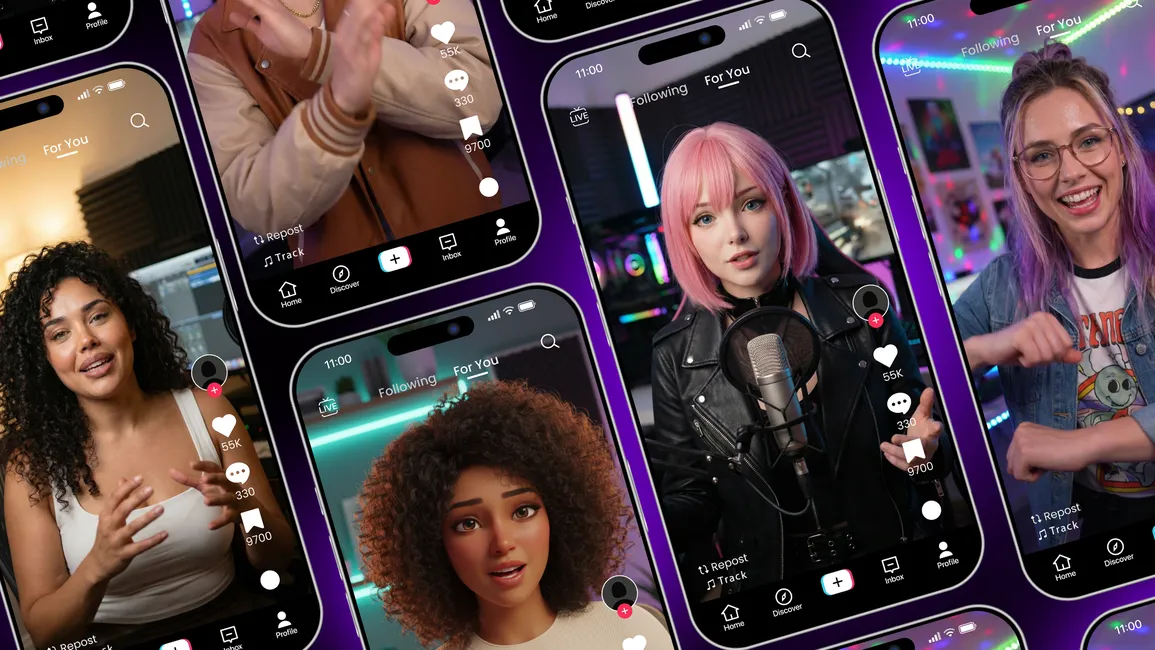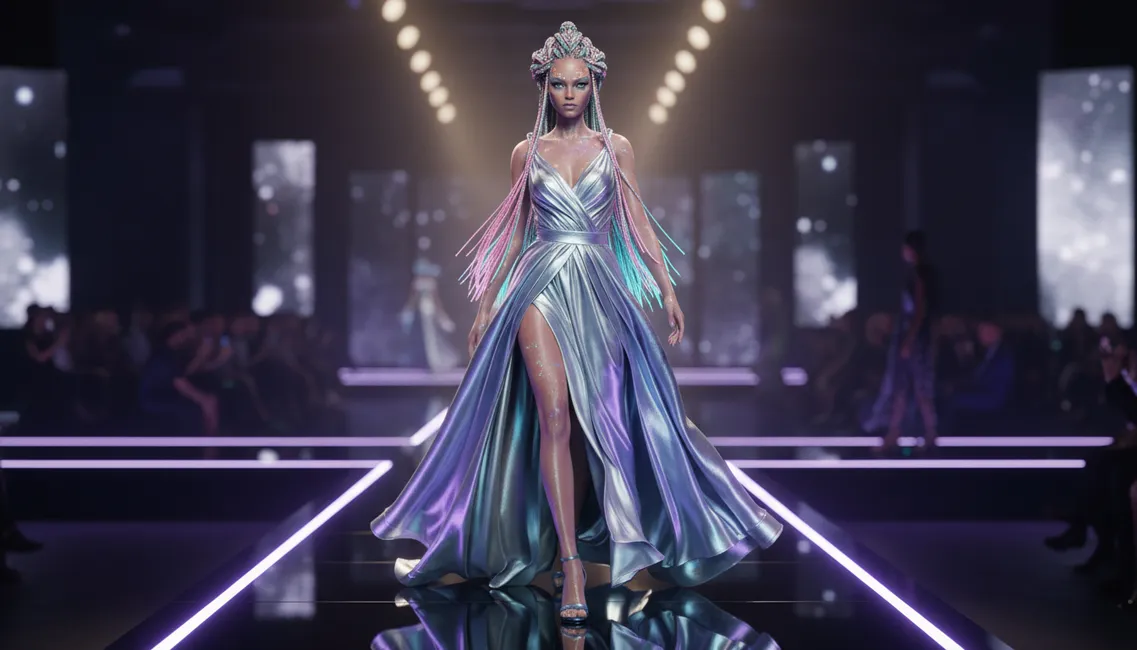
Creating a smart character that you can talk to — and even make creative videos with — is no longer a fantasy or a dream.
Interestingly, they’re starting to shake things up in the business world, and this is our main topic.
There are many names for these characters, such as AI influencer, virtual influencer, intelligent model, and several others.
In this article, we’ll focus specifically on AI vs. virtual influencers, highlighting their key differences.
AI influencers and Virtual influencers can offer numerous benefits.
In this blog, we’ll delve deep into the concept of this new form of influencers, which are trending and getting the spotlight.
So, let’s start by defining both separately.
What is a Virtual Influencer?
Put simply, a virtual influencer is a realistic or cartoon-style character — or even something as simple as a cactus — that plays the role of a social media influencer. It can offer the same benefits as a human influencer. A virtual influencer can generate income independently or belong to a brand or agency, aligning with that brand’s marketing goals.
So why aren’t more businesses using it — with bold, digital characters leading the way?

However, in a broader picture, these digital creations—known as virtual influencers—do not necessarily represent a unique brand. Most of the time, the primary goal behind their development is tied to advertising and marketing objectives.
Advanced technologies, such as CGI and motion capture, play a crucial part in developing virtual influencers, and thanks to technology’s rapid progress, they’re emerging at an astonishing pace.
If you need more information on this topic, read the blog “What is Virtual Influencer?”
As you read this blog, numerous virtual influencers are interacting with their followers and fans on social media platforms like Instagram. In the blog titled “Top 50 Virtual Influencers to Follow in 2025,” we examined many of them as worthy of attention.
Here are a few examples:
- Lil Miquela
- Shudu Gram
- Noonoouri
The world’s not slowing down, and your brand can’t afford to. As days pass, more and more brands are embracing virtual influencers in their digital marketing strategy. They’re becoming more mainstream than ever, and younger generations accept them with open arms.
From a business point of view, creating dedicated virtual influencers for your brand or even collaborating with outsiders offers several benefits, and overlooking them could mean missing out on major opportunities.
The modern age requires newer, more intelligent solutions. Speaking of intelligence, let’s examine the definition of an AI influencer in the next section of the blog.
What is an AI Influencer?
What happens when you mix AI with virtual influencers?
Simple.
You get an AI influencer.
How to create one? Just follow the stages of making a virtual influencer.
Face? Done.
Now comes the brain — AI algorithms can help us here.
Ultimately, you’ll have an AI influencer ready to jump into action anytime, anywhere.
Where do they come in handy?
There are hundreds (if not thousands) of AI-generated influencers creating content on diverse digital platforms. They’ve made their own fan base, gaining followers and influencing them in assorted ways.
By now, we understand that these modern-day influencers are naturally controllable and visually appealing. Moreover, since they’re not real human beings, they won’t get affected by typical troubles a real person would face. What troubles?
Illness, tiredness, mental breakdown, a rough morning after a late night, etc.
So they’re available 24/7 and are great choices for brands to assign them a number of responsibilities in the field of PR, customer support, and interacting with clients and prospects. And let’s not forget that compared to human experts, they’re incredibly cost-effective, considering they work tirelessly without even a second off.
Let us remind you of the magic that artificial intelligence will bring into action. More advanced models allow brands to empower virtual AI-enabled influencers with the required knowledge. The wisdom needed to respond to the most challenging inquiries by target audiences.
Have you noticed that a virtual influencer and an AI influencer are alike in many ways? Don’t fall for that trap.
Even though AI influencers are built upon the concept of virtual influencers, there are significant differences between these two. If you want to familiarize yourself with distinctions, continue reading this blog as we explore them in the next section.
The Real Line Between AI and Virtual Influencers
First things first.
In the creation phase, these two have a notable distinction.
Yes, AI is making a difference.
While CGI and motion capture technologies are used to create both virtual and AI influencers, developing the latter requires AI experts to work hard and bring it to life as intelligent digital beings.
We all agree that it’s a huge difference. Right?
Now, think of the benefits that AI delivers. What comes to mind? If it eliminates the need for human intervention, congratulations. You successfully uncovered the second difference without waiting for us to reveal it.
Virtual influencers are astonishing. But a higher power, a human employee, must control all their movements, from content creation to interaction with people.
Is it like a physical form of brand mascots that people wear at various events? Close call.
An AI influencer, on the other hand, needs no human input to manage its every move. What’s the point of being intelligent if it’s unable to handle tasks assigned to it?
Curious about the next difference? Let us give a hint.
Remember old chatbots that were so limited that one could tell they were programmed from a mile away? Exactly. That’s the next difference we’re talking about.
AI algorithms make AI influencers much more capable of efficiently interacting with audiences. On the other hand, virtual influencers are limited in terms of answering challenging questions. Why? Because they lack intelligence and are programmed with a few prepared responses to some frequently asked questions.
Is that all?
Not quite. The list goes on and on.
Virtual influencers publish the content created by marketers, while AI influencers can do this task independently.
Does that shock you? Have you ever used ChatGPT or other similar AI models?
They do precisely the same.
Lastly, we can see a significant difference regarding their purposes. Virtual influencers are mainly used for brand storytelling and to provide businesses consistency across different platforms.
AI influencers also offer the same usefulness, but brands often utilize them for real-time engagement and personalizing experiences.
So what’s the bottom line?
These concepts have much in common, but a savvy manager will also know their differences. Since we know you’re smart decision-makers, we must also inform you of their similarities.
If you’re looking to see how these concepts come to life in real campaigns, our Virtual Influencer Marketing: A Complete Guide breaks it all down—from strategy to execution.
Similarities and Common Ground
So, what do AI and virtual influencers have in common?
Quite a lot, actually.
Both are digital entities designed to exist and operate in virtual spaces. While they’re not human, they aim to emulate human behavior convincingly—walking, talking, posing, even influencing—just like real people.
Despite all the high-tech hype, neither of them functions entirely on autopilot. Human involvement remains essential.
Wait—didn’t we just say that AI influencers don’t require human input? Wasn’t that one of their key differentiators?
Yes, but here’s the nuance: even the most autonomous AI influencers still rely on expert supervision. AI specialists are needed to train, fine-tune, and monitor their behavior to ensure they deliver consistent, brand-aligned results.
Now, here’s where modern technology truly shines: it allows us to create stunning, highly customized digital personas—whether they’re AI-driven or manually controlled virtual influencers. In both cases, you gain flexibility to design characters that visually and behaviorally align with your brand identity.
Unlike human influencers, these digital counterparts don’t get tired, sick, or tangled in controversy. They don’t take vacations, and they’re not bound by geography. With the right development, they can become multilingual brand ambassadors, available 24/7, capable of engaging diverse markets simultaneously.
And their mission?
It’s largely the same: whether powered by AI or controlled behind the scenes, both types of influencers are built to amplify brand visibility, generate leads, and boost engagement across digital channels.
There’s one more thing they share: their natural habitat.
Social media is their playground.
You’ve probably seen terms like Instagram AI influencers or spotted virtual characters going viral on TikTok or YouTube. That’s because these platforms offer the perfect stage for them to perform, connect, and build community.
Starting to see the overlap?
Good.
Now, the real question becomes: when should you choose one over the other?
Let’s break that down—next.
Both Have Value—Here’s When Each One Works Best
What’s the use of virtual influencers when AI-powered ones offer much more capabilities?
Well, it’s not that simple. Intelligence comes at a cost — and it doesn’t always work in your favor.
Many businesses prefer a controllable influencer, which we know virtual influencers are, rather than assigning some critical roles to AI influencers.
What if we provide you with a list of times when virtual influencers are the best choice?
Here we go:
- Story-driven campaigns
- Short-term product launches
- Attracting Gen Z attention
In one sentence:
Opt for virtual influencers when you need to control everything and avoid using them for unprogrammed, deep, personalized interaction.
Ready to go to the other side of this river ___ where AI influencers are soaking up the spotlight?
Select an AI influencer for:
- Interactive engagement with audiences
- Conversational marketing
- Offering a gamified and immersive experience
The magic that artificial intelligence brings to the table delivers significant edges. However, as said earlier, you should shoulder a heavier responsibility since you’ll have less control over how the influencer behaves.
Want to avoid trouble?
Never use an AI-powered influencer for campaigns that require full control.
Well, when it’s possible, why not?
Numerous businesses have already started taking this hybrid approach, where they can experience the best of both worlds.
This way, they can control the influencer whenever needed or leave it to operate independently and automate several repetitive tasks when nothing critical is in place.
Now, all that’s left is the final conclusion.
Time to Create Your Brand’s Digital Face
Most businesses don’t have access to the required resources to build their own digital characters.
Creating a character that connects to AI is a more complex task.
So, does that mean you can’t benefit from an AI influencer?
Of course not. We’re here to help you.
Virtual influencer creation is one of the services we offer at Dream Farm Agency. Our skilled experts have worked with multiple brands and made their digital faces.
We have experience in delivering a high-quality outcome that perfectly matches your needs and brand’s identity.
Your competitors are already on this path—don’t get left behind. To stay in the competition, you’ll definitely need a virtual influencer.
Why hesitate? Call us now, and let’s start your project.
Nikan



